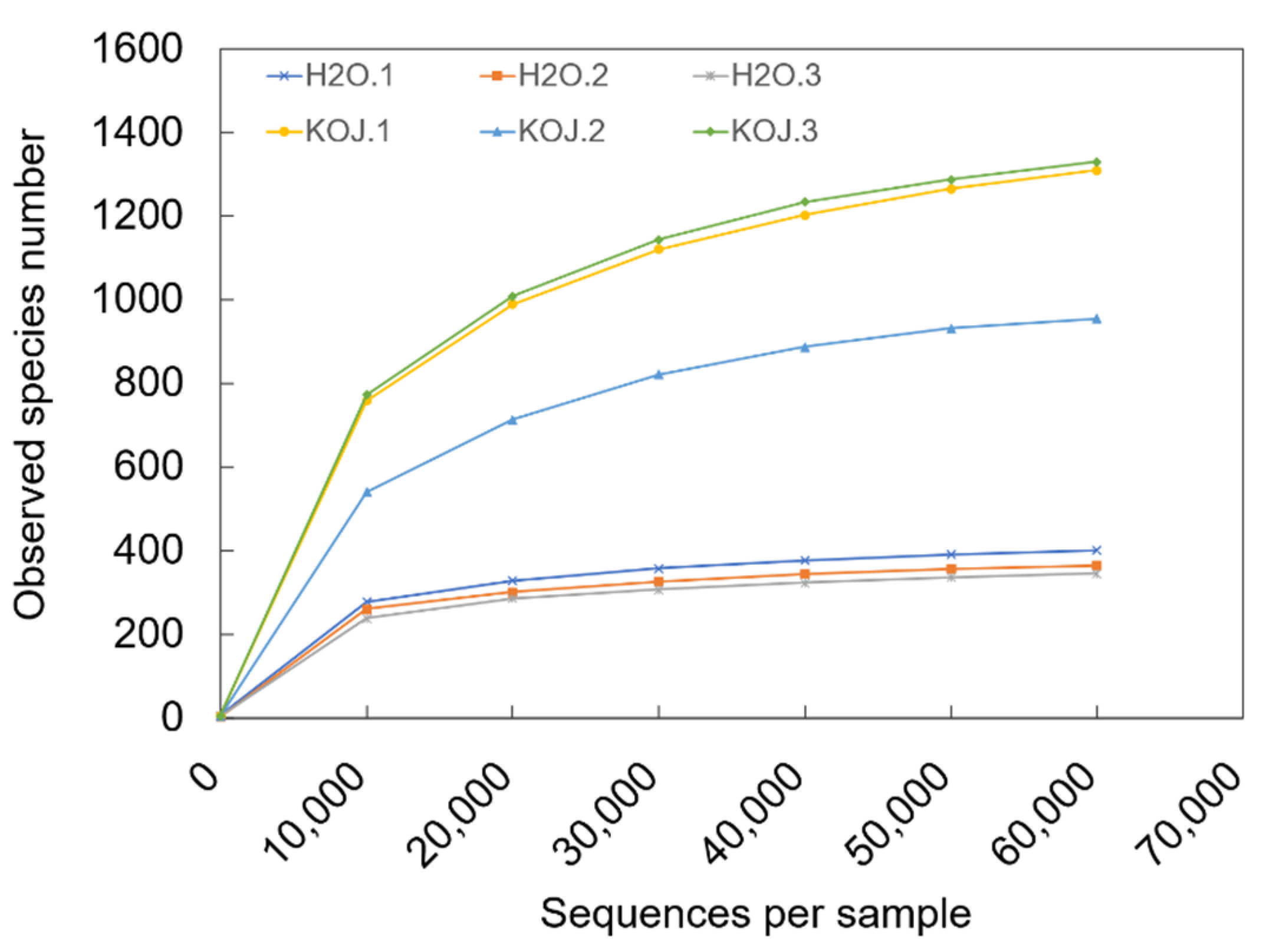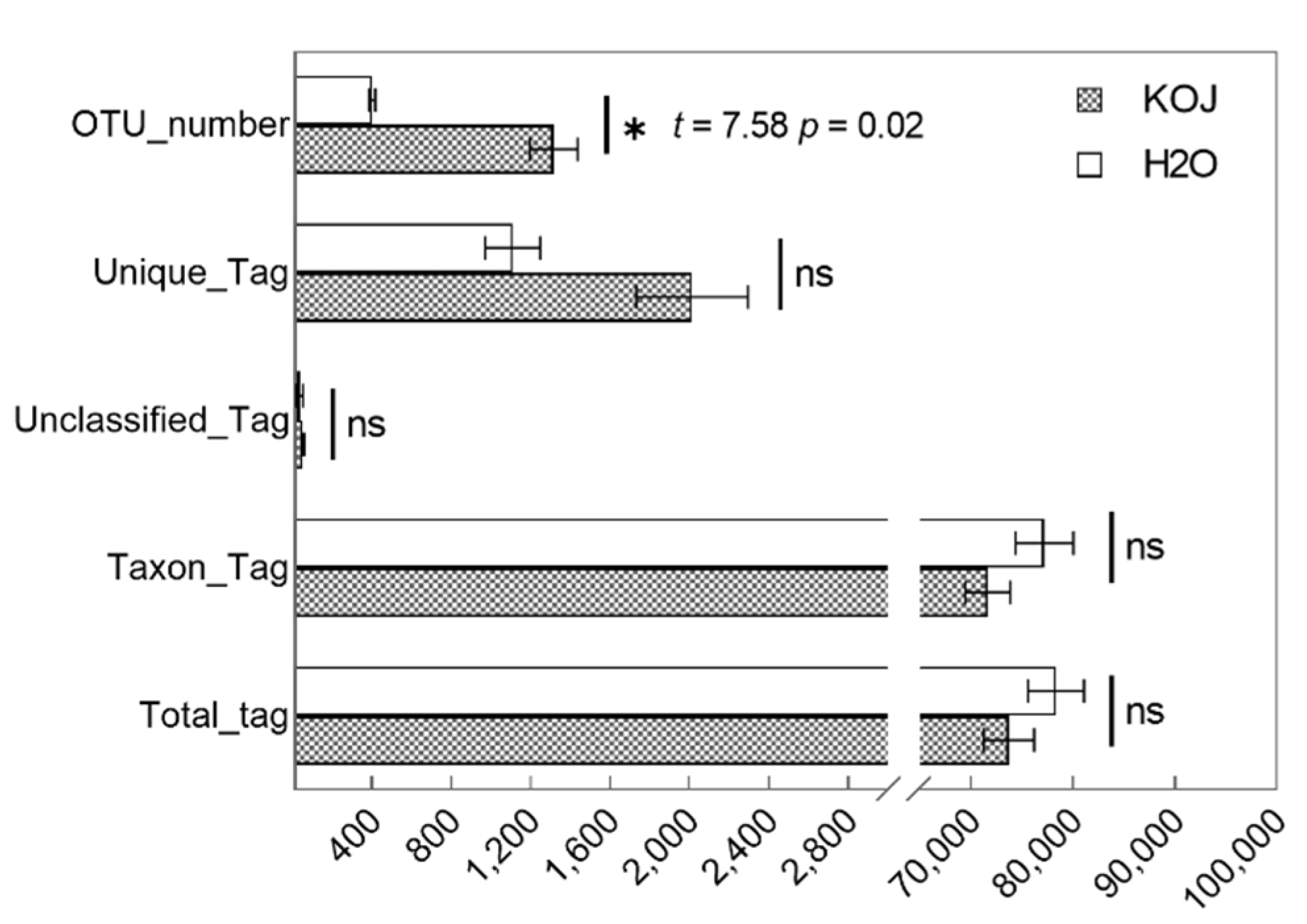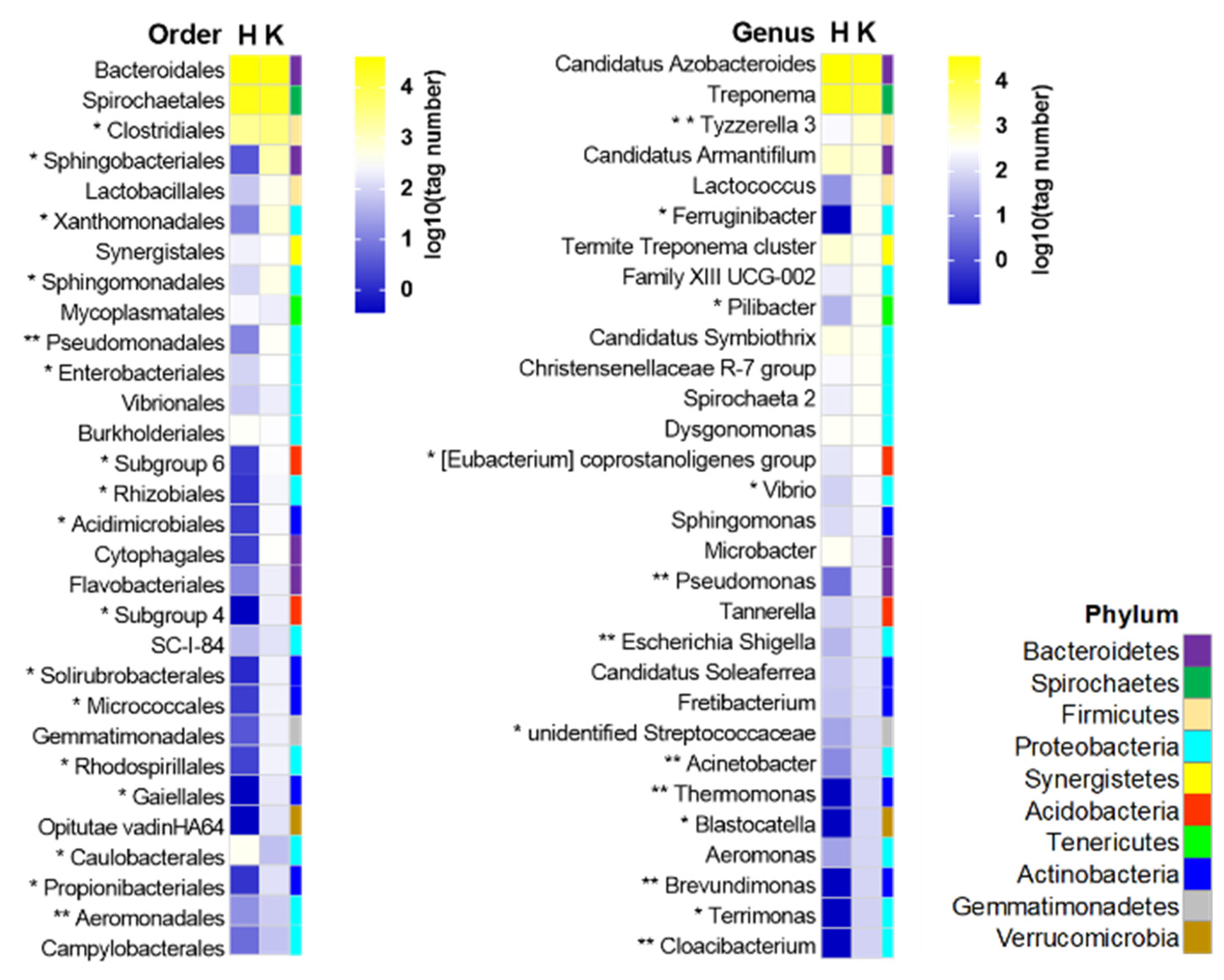Collaborative Response of the Host and Symbiotic Lignocellulytic System to Non-Lethal Toxic Stress in Coptotermes formosanus Skiraki
Abstract
Simple Summary
Abstract
1. Introduction
2. Materials and Methods
2.1. Termite Collection, Kojic acid Treatment and Feeding Assays
2.2. Crude Enzyme Extraction and Protein Concentration Assays
2.3. Enzyme Activity Assays
2.4. Total RNA Isolation and Quantitative Real-Time PCR
2.5. Microscopic Examination and Counting of Protozoa
2.6. High-Throughput Sequencing of 16S rRNA Gene Library and Sequence Processing
2.7. Bacterial Community Composition and Structural Analysis
2.8. Statistical Methods
3. Results
3.1. Effect of Kojic Acid Treatment on the Physiological State of Termites
3.2. Variation in Cellulase Activities
3.3. Variation in the Levels of Transcription of the Lignocellulolytic Genes
3.4. Effect of Kojic Acid Treatment on Population Size of Flagellates
3.5. Effect of Kojic Acid Treatment on the Symbiotic Bacterial Community of the Hindgut
4. Discussion
4.1. Differential Response of Dual-Origin Cellulolytic Enzymes to Kojic Acid Treatment
4.2. Possibility of Rare Bacterial Communities Participating in Oxidative Detoxification
5. Conclusions
Supplementary Materials
Author Contributions
Funding
Institutional Review Board Statement
Informed Consent Statement
Data Availability Statement
Conflicts of Interest
References
- Karl, Z.J.; Scharf, M.E. Effects of five diverse lignocellulosic diets on digestive enzyme biochemistry in the termite Reticulitermes flavipes. Arch. Insect Biochem. Physiol. 2015, 90, 89–103. [Google Scholar] [CrossRef]
- Tarmadi, D.; Yoshimura, T.; Tobimatsu, Y.; Yamamura, M.; Umezawa, T. Effects of lignins as diet components on the physiological activities of a lower termite, Coptotermes formosanus Shiraki. J. Insect Physiol. 2017, 103, 57–63. [Google Scholar] [CrossRef]
- Zhang, D.; Lax, A.R.; Bland, J.M.; Yu, J.; Fedorova, N.; Nierma, W.C. Hydrolysis of filter-paper cellulose to glucose by two recombinant endogenous glycosyl hydrolases of Coptotermes formosanus. Insect Sci. 2010, 17, 245–252. [Google Scholar] [CrossRef]
- Ohkuma, M. Symbioses of flagellates and prokaryotes in the gut of lower termites. Trends. Microbiol. 2008, 16, 345–352. [Google Scholar] [CrossRef]
- Xie, L.; Zhang, L.; Zhong, Y.; Liu, N.; Long, Y.; Wang, S.; Zhou, X.; Zhou, Z.; Huang, Y.; Wang, Q. Profiling the metatranscriptome of the protistan community in Coptotermes formosanus with emphasis on the lignocellulolytic system. Genomics 2012, 99, 246–255. [Google Scholar] [CrossRef] [PubMed]
- Zeng, W.; Liu, B.; Zhong, J.; Li, Q.; Li, Z. A natural high-sugar diet has different effects on the prokaryotic community structures of lower and higher termites (Blattaria). Environ. Entomol. 2020, 49, 21–32. [Google Scholar] [CrossRef]
- Nishimura, Y.; Otagiri, M.; Yuki, M.; Shimizu, M.; Inoue, J.I.; Moriya, S.; Ohkuma, M. Division of functional roles for termite gut protists revealed by single-cell transcriptomes. ISME J. 2020, 14, 2449–2460. [Google Scholar] [CrossRef] [PubMed]
- Geng, A.; Cheng, Y.; Wang, Y.; Zhu, D.; Le, Y.; Wu, J.; Xie, R.; Yuan, J.S.; Sun, J. Transcriptome analysis of the digestive system of a wood-feeding termite (Coptotermes formosanus) revealed a unique mechanism for effective biomass degradation. Biotechnol. Biofuels 2018, 11. [Google Scholar] [CrossRef] [PubMed]
- Arakawa, G.; Watanabe, H.; Yamasaki, H.; Maekawa, H.; Tokuda, G. Purification and molecular cloning of xylanases from the wood-feeding termite, Coptotermes formosanus Shiraki. Biosci. Biotechnol. Biochem. 2009, 73, 710–718. [Google Scholar] [CrossRef] [PubMed]
- Hongoh, Y. Toward the functional analysis of uncultivable, symbiotic microorganisms in the termite gut. Cell Mol. Life Sci. 2011, 68, 1311–1325. [Google Scholar] [CrossRef] [PubMed]
- Ohtoko, K.; Ohkuma, M.; Moriya, S.; Inoue, T.; Usami, R.; Kudo, T. Diverse genes of cellulase homologues of glycosyl hydrolase family 45 from the symbiotic protists in the hindgut of the termite Reticulitermes speratus. Extremophiles 2000, 4, 343–349. [Google Scholar] [CrossRef]
- Noda, S.; Iida, T.; Kitade, O.; Nakajima, H.; Kudo, T.; Ohkuma, M. Endosymbiotic Bacteroidales bacteria of the flagellated protist Pseudotrichonympha grassii in the gut of the termite Coptotermes formosanus. Appl. Environ. Microbiol 2005, 71, 8811–8817. [Google Scholar] [CrossRef] [PubMed]
- Brune, A. Symbiotic digestion of lignocellulose in termite guts. Nat. Rev. Microbiol. 2014, 12, 168–180. [Google Scholar] [CrossRef]
- Peterson, B.F.; Scharf, M.E. Lower termite associations with microbes: Synergy, protection, and interplay. Front. Microbiol. 2016, 7. [Google Scholar] [CrossRef] [PubMed]
- Edith, M.M.; Nancy, L.M.B.; Zipporah, L.O.; Hamadi, I.B.; Huxley, M.M. Isolation and characterization of some gut microbial symbionts from fungus-cultivating termites (Macrotermes and Odontotermes spp.). Afr. J. Microbiol. Res. 2016, 10, 955–1003. [Google Scholar] [CrossRef][Green Version]
- Ke, J.; Sun, J.; Nguyen, H.D.; Singh, D.; Lee, K.C.; Beyenal, H.; Chen, S. In-situ oxygen profiling and lignin modification in guts of wood-feeding termites. Insect Sci. 2010, 119–132. [Google Scholar] [CrossRef]
- Lucey, K.S.; Leadbetter, J.R. Catechol 2,3-dioxygenase and other meta-cleavage catabolic pathway genes in the ‘anaerobic’ termite gut spirochete Treponema primitia. Mol. Ecol. 2014, 23, 1531–1543. [Google Scholar] [CrossRef] [PubMed]
- Roes-Hill, M.L.; Rohland, J.; Burton, S. Actinobacteria isolated from termite guts as a source of novel oxidative enzymes. Antonie. Leeuwenhoek 2011, 100, 589–605. [Google Scholar] [CrossRef]
- Tartar, A.; Wheeler, M.M.; Zhou, X.; Coy, M.R.; Boucias, D.G.; Scharf, M.E. Parallel metatranscriptome analyses of host and symbiont gene expression in the gut of the termite Reticulitermes flavipes. Biotechnol. Biofuels 2009, 2. [Google Scholar] [CrossRef]
- Zhou, H.; Guo, W.; Xu, B.; Teng, Z.; Tao, D.; Lou, Y.; Gao, Y. Screening and identification of lignin-degrading bacteria in termite gut and the construction of LiP-expressing recombinant Lactococcus lactis. Microb. Pathog. 2017, 112. [Google Scholar] [CrossRef]
- Fujita, A.; Hojo, M.; Aoyagi, T.; Hayashi, Y.; Arakawa, G.; Tokuda, G.; Watanabe, H. Details of the digestive system in the midgut of Coptotermes formosanus Shiraki. J. Wood Sci. 2010, 56, 222–226. [Google Scholar] [CrossRef]
- Geng, A.; Wu, J.; Xie, R.R.; Li, X.; Chang, F.X.; Sun, J.Z. Characterization of a laccase from a wood-feeding termite, Coptotermes formosanus. Insect Sci. 2018, 25, 251–258. [Google Scholar] [CrossRef]
- Zhou, X.; Wheeler, M.M.; Oi, F.M.; Scharf, M.E. Inhibition of termite cellulases by carbohydrate-based cellulase inhibitors: Evidence from in vitro biochemistry and in vivo feeding studies. Pestic. Biochem. Phys. 2008, 90, 31–41. [Google Scholar] [CrossRef]
- Zhu, B.C.; Henderson, G.; Laine, R.A. Screening method for inhibitors against formosan subterranean termite beta-glucosidases in vivo. J. Econ. Entomol. 2005, 98, 41–46. [Google Scholar] [CrossRef] [PubMed]
- Alverson, J. Effects of mycotoxins, kojic acid and oxalic acid, on biological fitness of Lygus hesperus (Heteroptera: Miridae). J. Invertebr. Pathol. 2003, 83, 60–62. [Google Scholar] [CrossRef]
- Wang, S.D.; Wan-chun, L.; Xing-xiang, G.; Ding, Q. Inhibitory effects of kojic acid on phenoloxidase of diamondback moth Plutella xylostella. J. Integr. Agric. 2004, 003, 923–930. [Google Scholar]
- Murao, S.; Hinode, Y.; Matsumura, E.; Numata, A.; Kawai, K.; Ohishi, H.; Jin, H.; Oyama, H.; Shin, T. A novel laccase inhibitor, N-hydroxyglycine, produced by Penicillium citrinum YH-31. Biosci. Biotech. Bioch. 1992, 56, 987–988. [Google Scholar] [CrossRef][Green Version]
- Boucias, D.G.; Cai, Y.; Sun, Y.; Lietze, V.U.; Sen, R.; Raychoudhury, R.; Scharf, M.E. The hindgut lumen prokaryotic microbiota of the termite Reticulitermes flavipes and its responses to dietary lignocellulose composition. Mol. Ecol. 2013, 22, 1836–1853. [Google Scholar] [CrossRef] [PubMed]
- Zeng, W.H.; Li, Z.Q.; Liu, B.R.; Li, Q.J.; Zhong, J.H. Disruption of Coptotermes formosanus (Isoptera: Rhinotermitidae) gut microbiota reproduction and its consequences for the cellulolytic system. J. Entomol. Sci. 2016, 51, 138–150. [Google Scholar] [CrossRef]
- Zeng, W.; Zhiqiang, L.; Bingrong, L.; Li, Q.; Zhong, J. Correlation between rearing temperature and the dual cellulolytic system of Coptotermes formosanus Shiraki and its intestinal microenvironment. J. Asia Pac. Entomol. 2016, 19, 209–215. [Google Scholar] [CrossRef]
- Willis, J.D.; Oppert, B.; Oppert, C.; Klingeman, W.E.; Jurat-Fuentes, J.L. Identification, cloning, and expression of a GHF9 cellulase from Tribolium castaneum (Coleoptera: Tenebrionidae). J. Insect Physiol. 2011, 57, 300–306. [Google Scholar] [CrossRef]
- Eveleigh, D.E.; Mandels, M.; Andreotti, R.; Roche, C. Measurement of saccharifying cellulase. Biotechnol. Biofuels. 2009, 2. [Google Scholar] [CrossRef]
- Zhou, X.; Smith, J.A.; Oi, F.M.; Koehler, P.G.; Bennett, G.W.; Scharf, M.E. Correlation of cellulase gene expression and cellulolytic activity throughout the gut of the termite Reticulitermes flavipes. Gene 2007, 395, 29–39. [Google Scholar] [CrossRef]
- Livak, K.J.; Schmittgen, T.D. Analysis of relative gene expression data using real-time quantitative PCR and the 2(-Delta Delta C(T)) method. Methods 2001, 25, 402–408. [Google Scholar] [CrossRef]
- Caporaso, J.G.; Lauber, C.L.; Walters, W.A.; Berglyons, D.; Lozupone, C.A.; Turnbaugh, P.J.; Fierer, N.; Knight, R. Global patterns of 16S rRNA diversity at a depth of millions of sequences per sample. Proc. Natl. Acad. Sci. USA 2011, 108. [Google Scholar] [CrossRef]
- Magoc, T.; Salzberg, S.L. FLASH: Fast length adjustment of short reads to improve genome assemblies. Bioinformatics 2011, 27, 2957–2963. [Google Scholar] [CrossRef]
- Segata, N.; Izard, J.; Waldron, L.; Gevers, D.; Miropolsky, L.; Garrett, W.S.; Huttenhower, C. Metagenomic biomarker discovery and explanation. Genome Biol. 2011, 12. [Google Scholar] [CrossRef] [PubMed]
- Sethi, A.; Karl, Z.J.; Scharf, M.E. Digestion of Termiticide Bait Matrices by the Pest Termite Reticulitermes flavipes (Isoptera: Rhinotermitidae). J. Econ. Entomol. 2016, 109, 982–986. [Google Scholar] [CrossRef]
- Coy, M.R.; Salem, T.Z.; Denton, J.S.; Kovaleva, E.S.; Liu, Z.; Barber, D.S.; Campbell, J.H.; Davis, D.C.; Buchman, G.W.; Boucias, D.G.; et al. Phenol-oxidizing laccases from the termite gut. Insect Biochem. Mol. Biol. 2010, 40, 723–732. [Google Scholar] [CrossRef]
- Raychoudhury, R.; Sen, R.; Cai, Y.; Sun, Y.; Lietze, V.U.; Boucias, D.G.; Scharf, M.E. Comparative metatranscriptomic signatures of wood and paper feeding in the gut of the termite Reticulitermes flavipes (Isoptera: Rhinotermitidae). Insect Mol. Biol. 2013, 22, 155–171. [Google Scholar] [CrossRef] [PubMed]
- Scharf, M.E.; Karl, Z.J.; Sethi, A.; Boucias, D.G. Multiple levels of synergistic collaboration in termite lignocellulose digestion. PLoS ONE 2011, 6, e21709. [Google Scholar] [CrossRef] [PubMed]
- Sethi, A.; Slack, J.M.; Kovaleva, E.S.; Buchman, G.W.; Scharf, M.E. Lignin-associated metagene expression in a lignocellulose-digesting termite. Insect Biochem. Molec. 2013, 43, 91–101. [Google Scholar] [CrossRef]
- Tabka, M.G.; Herpol-Gimbert, I.; Monod, F.; Asther, M.; Sigoillot, J.C. Enzymatic saccharification of wheat straw for bioethanol production by a combined cellulase xylanase and feruloyl esterase treatment. Enzym. Microb. Tech. 2006, 39, 897–902. [Google Scholar] [CrossRef]
- Kim, Y.; Yeo, S.; Kim, M.K.; Choi, H.T. Removal of estrogenic activity from endocrine-disrupting chemicals by purified laccase of Phlebia tremellosa. FEMS Microbiol Lett. 2008, 284, 172–175. [Google Scholar] [CrossRef] [PubMed][Green Version]
- Noda, S.; Ohkuma, M.; Yamada, A.; Hongoh, Y.; Kudo, T. Phylogenetic position and in situ identification of ectosymbiotic spirochetes on protists in the termite gut. Appl. Environ. Microbiol 2003, 69, 625–633. [Google Scholar] [CrossRef]
- Hongoh, Y.; Sharma, V.K.; Prakash, T.; Noda, S.; Toh, H.; Taylor, T.D.; Kudo, T.; Sakaki, Y.; Toyoda, A.; Hattori, M.; et al. Genome of an endosymbiont coupling N2 fixation to cellulolysis within protist cells in termite gut. Science 2008, 322. [Google Scholar] [CrossRef]
- Su, L.; Yang, L.; Huang, S.; Li, Y.; Su, X.; Wang, F.; Bo, C.; Wang, E.T.; Song, A. Variation in the gut microbiota of termites (Tsaitermes ampliceps) against different diets. Appl. Biochem. Biotechnol. 2017, 181, 32–47. [Google Scholar] [CrossRef]
- Tai, V.; James, E.R.; Nalepa, C.A.; Scheffrahn, R.H.; Perlman, S.J.; Keeling, P.J. The role of host phylogeny varies in shaping microbial diversity in the hindguts of lower termites. Appl. Environ. Microb. 2015, 81, 1059–1070. [Google Scholar] [CrossRef]
- Jones, R.T.; Sanchez, L.G.; Fierer, N. A cross-taxon analysis of insect-associated bacterial diversity. PLoS ONE 2013, 8, e61218. [Google Scholar] [CrossRef] [PubMed]
- Tarmadi, D.; Tobimatsu, Y.; Yamamura, M.; Miyamoto, T.; Miyagawa, Y.; Umezawa, T.; Yoshimura, T. NMR studies on lignocellulose deconstructions in the digestive system of the lower termite Coptotermes formosanus Shiraki. Sci. Rep. 2018, 8. [Google Scholar] [CrossRef]
- Harazono, K.; Yamashita, N.; Shinzato, N.; Watanabe, Y.; Fukatsu, T.; Kurane, R. Isolation and characterization of aromatics-degrading microorganisms from the gut of the lower termite Coptotermes formosanus. Biosci. Biotechnol Biochem. 2003, 67, 889–892. [Google Scholar] [CrossRef] [PubMed]
- Thongaram, T.; Hongoh, Y.; Kosono, S.; Ohkuma, M.; Trakulnaleamsai, S.; Noparatnaraporn, N.; Kudo, T. Comparison of bacterial communities in the alkaline gut segment among various species of higher termites. Extremophiles 2005, 9, 229–238. [Google Scholar] [CrossRef] [PubMed]
- Mikaelyan, A.; Meuser, K.; Brune, A. Microenvironmental heterogeneity of gut compartments drives bacterial community structure in wood- and humus-feeding higher termites. FEMS Microbiol. Ecol. 2017, 93. [Google Scholar] [CrossRef] [PubMed]







| Gene Name | Tissue localization | Primers (5′–3′) | GenBank Accession No. |
|---|---|---|---|
| lac | Salivary gland | F: CTCCCGGACATCAACTATCTTC R: GCATAGGATGTCGTCTGGTACA | KX386002.1 |
| eg | F: CTGCCATCGCCTACAAGAGTGCT R: GTGTTGTCGTTGGTCGCCCTGTA | EU853671.1 | |
| bg | F: AGTGGCCCGAGTCTGCTTCTTC R: CGCAGCCATTCGAAGTTGTCTAT | GQ911585.1 | |
| Peg | Protist: Pseudotrichonympha grassii | F: GAGTGAATGTGGTGGAATGGAATC R: GCCATGGAGGATTGACAGGAC | AB071001.1 |
| Pcbh | F: TGGACTGAATGGTGCACTCTACTT R: CATTTTCATCATTCGTTTGTGGTT | AB071864.1 | |
| Pex | Protist: Holomastigotoides hartmanni | F: ATCAGTTTTGGAGTGTGCGTCAGG R: TTATATCCGAACTCCCGCTGCTC | AB469374 |
| Assays | Kojic Acid | Distilled Water | p-Value | |
|---|---|---|---|---|
| Mortality (%) | 4.87 ± 0.47 | 4.16 ± 0.66 | 0.75 | |
| Feeding amount (mg) a | 13.00 ± 0.53 | 15.34 ± 1.14 | 0.07 | |
| PO activity (U/mg protein) | WB | 0.53 ± 0.07 | 0.91 ± 0.07 | 0.02 |
| FS | 0.91 ± 0.14 | 1.38 ± 0.03 | 0.03 | |
| H | 0.28 ± 0.08 | 0.31 ± 0.04 | 0.78 | |
| Alpha Diversity Index | Distilled Water | Kojic Acid | Tukey p-Value |
|---|---|---|---|
| Observed species | 371 ± 16 | 1198 ± 121 | 0.005 |
| ACE | 403.82 ± 17.75 | 1304.89 ± 145.78 | 0.008 |
| Chao1 | 403.95 ± 19.64 | 1290.93 ± 155.52 | 0.008 |
| PD whole tree | 38.99 ± 1.19 | 91.54.99 ± 6.12 | 0.004 |
| Shannon | 4.15 ± 0.44 | 5.41 ± 0.25 | 0.068 |
| Simpson | 0.74 ± 0.08 | 0.84 ± 0.02 | 0.402 |
| Phylum | Relative Abundance (%) | Absolute Abundance (Tag Number) | Significant Shift Taxa (Number) | |||
|---|---|---|---|---|---|---|
| H2O | KOJ | H2O | KOJ | Upregulated | Downregulated | |
| Bacteroidetes | 53.71 | 46.01 | 41899 | 32913 | 10 | 0 |
| Firmicutes * | 3.43 | 9.27 | 2763 | 6708 | 9 | 0 |
| Proteobacteria * | 2.02 | 4.93 | 1552 | 3586 | 27 | 0 |
| Actinobacteria * | 1.21 | 3.35 | 928 | 2738 | 12 | 0 |
| Verrucomicrobia * | 0.55 | 0.25 | 423 | 180 | 0 | 3 |
| Acidobacteria * | 0.00 | 0.85 | 2 | 622 | 8 | 0 |
| Chloroflexi * | 0.00 | 0.38 | 0 | 273 | 1 | 0 |
Publisher’s Note: MDPI stays neutral with regard to jurisdictional claims in published maps and institutional affiliations. |
© 2021 by the authors. Licensee MDPI, Basel, Switzerland. This article is an open access article distributed under the terms and conditions of the Creative Commons Attribution (CC BY) license (https://creativecommons.org/licenses/by/4.0/).
Share and Cite
Zeng, W.; Liu, B.; Wu, W.; Zhang, S.; Chen, Y.; Li, Z. Collaborative Response of the Host and Symbiotic Lignocellulytic System to Non-Lethal Toxic Stress in Coptotermes formosanus Skiraki. Insects 2021, 12, 510. https://doi.org/10.3390/insects12060510
Zeng W, Liu B, Wu W, Zhang S, Chen Y, Li Z. Collaborative Response of the Host and Symbiotic Lignocellulytic System to Non-Lethal Toxic Stress in Coptotermes formosanus Skiraki. Insects. 2021; 12(6):510. https://doi.org/10.3390/insects12060510
Chicago/Turabian StyleZeng, Wenhui, Bingrong Liu, Wenjing Wu, Shijun Zhang, Yong Chen, and Zhiqiang Li. 2021. "Collaborative Response of the Host and Symbiotic Lignocellulytic System to Non-Lethal Toxic Stress in Coptotermes formosanus Skiraki" Insects 12, no. 6: 510. https://doi.org/10.3390/insects12060510
APA StyleZeng, W., Liu, B., Wu, W., Zhang, S., Chen, Y., & Li, Z. (2021). Collaborative Response of the Host and Symbiotic Lignocellulytic System to Non-Lethal Toxic Stress in Coptotermes formosanus Skiraki. Insects, 12(6), 510. https://doi.org/10.3390/insects12060510






